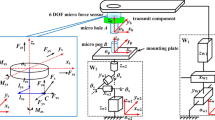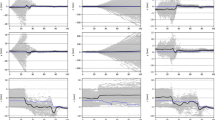Abstract
Precision parts are difficult to assemble using only position control. To deal with this difficulty, force control approaches, which provide proper motion responses against contact forces, are investigated. Moreover, hole detection is a crucial step in eliminating the uncertainty in robotic assembly. Without a proper hole detection algorithm, assembly time increases with the position difference between the peg and the hole. In this study, we propose a shape recognition algorithm based on a 6-axis F/T sensor and a hole detection algorithm. The proposed hole detection algorithm can find the direction of a hole regardless of the size of the position error between the peg and the hole with some overlap of the hole and the peg. The same algorithm can be implemented not only for a circular peg, but also for a polygonal convex peg. A series of experimental results show that the proposed algorithms can estimate the shape and location of a peg reasonably well.
Similar content being viewed by others
References
Pan, Z., Zhang, H., Zhu, Z., and Wang, J., “Chatter Analysis of Robotic Machining Process,” Journal of Materials Processing Technology, Vol. 173, No. 3, pp. 301–309, 2006.
Whitney, D. E., “Mechanical Assemblies: Their Design, Manufacture, and Role in Product Development,” Oxford University Press, pp. 253–292, 2004.
Stemmer, A., Schreiber, G., Arbter, K., and Albu-Schäffer, A., “Robust Assembly of Complex Shaped Planar Parts Using Vision and Force,” Proc. of IEEE International Conference on Multisensor Fusion and Integration for Intelligent Systems, pp.493–500, 2006.
Chen, H., Zhang, G., Zhang, H., and Fuhlbrigge, T. A., “Integrated Robotic System for High Precision Assembly in a Semi-Structured Environment,” Assembly Automation, Vol. 27, No. 3, pp. 247–252, 2007.
Bruyninckx, H., Dutre, S., and De Schutter, J., “Peg-on-Hole: a Model based Solution to Peg and Hole Alignment,” Proc. of International Conference on Robotics and Automation, Vol. 2, pp. 1919–1924, 1995.
Caine, M. E., Lozano-Pérez, T., and Seering, W. P., “Assembly Strategies for Chamferless Parts,” Proc. of IEEE International Conference on Robotics and Automation, Vol. 1, pp. 472–477, 1989.
Je, H. W., Baek, J. Y., and Lee, M. C., “Current based Compliance Control Method for Minimizing an Impact Force at Collision of Service Robot Arm,” Int. J. Precis. Eng. Manuf., Vol. 12, No. 2, pp. 251–258, 2011.
Kumar, N., Panwar, V., Sukavanam, N., Sharma, S. P., and Borm, J. H., “Neural Network based Hybrid Force/Position Control for Robot Manipulators,” Int. J. Precis. Eng. Manuf., Vol. 12, No. 3, pp. 419–426, 2011.
Chhatpar, S. R. and Branicky, M. S., “Search Strategies for Peg-in-Hole Assemblies with Position Uncertainty,” Proc. of IEEE/RSJ International Conference on Intelligent Robots and Systems, pp. 1465–1470, 2001.
Marvel, J. A. and Newman, W. S., “Model-Assisted Stochastic Learning for Robotic Applications,” IEEE Transactions on Automation Science and Engineering, Vol. 8, No. 4, pp. 835–845, 2011.
Chhatpar, S. R. and Branicky, M. S., “Particle Filtering for Localization in Robotic Assemblies with Position Uncertainty,” Proc. of IEEE/RSJ International Conference on Intelligent Robots and Systems, pp. 3610–3617, 2005.
Rozo, L., Jiménez, P., and Torras, C., “A Robot Learning from Demonstration Framework to Perform Force-based Manipulation Tasks,” Intelligent Service Robotics, Vol. 6, No. 1, pp. 33–51, 2013.
Newman, W., Birkhimer, C., and Hebbar, R., “Towards Automatic Transfer of Human Skills for Robotic Assembly,” Proc. of IEEE/RSJ International Conference on Intelligent Robots and Systems, pp. 2528–2533, 2003.
Mercimek, M., Gulez, K., and Mumcu, T. V., “Real Object Recognition using Moment Invariants,” Sadhana, Vol. 30, No. 6, pp. 765–775, 2005.
Glosser, G. D. and Newman, W. S., “The Implementation of a Natural Admittance Controller on an Industrial Manipulator,” Proc. of IEEE International Conference on Robotics and Automation, Vol. 2, pp. 1209–1215, 1994.
Tsuda, M., Takahashi, T., and Ogata, H., “Creating an Assembly-Task Model by Human Demonstration,” Proc. of IEEE International Conference on Systems, Man, and Cybernetics, Vol. 4, pp. 1007–1013, 1999.
Author information
Authors and Affiliations
Corresponding author
Rights and permissions
About this article
Cite this article
Kim, YL., Song, HC. & Song, JB. Hole detection algorithm for chamferless square peg-in-hole based on shape recognition using F/T sensor. Int. J. Precis. Eng. Manuf. 15, 425–432 (2014). https://doi.org/10.1007/s12541-014-0353-6
Received:
Revised:
Accepted:
Published:
Issue Date:
DOI: https://doi.org/10.1007/s12541-014-0353-6




